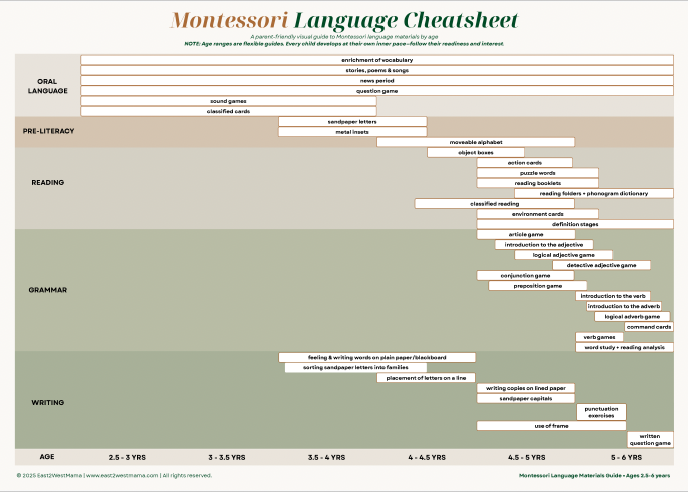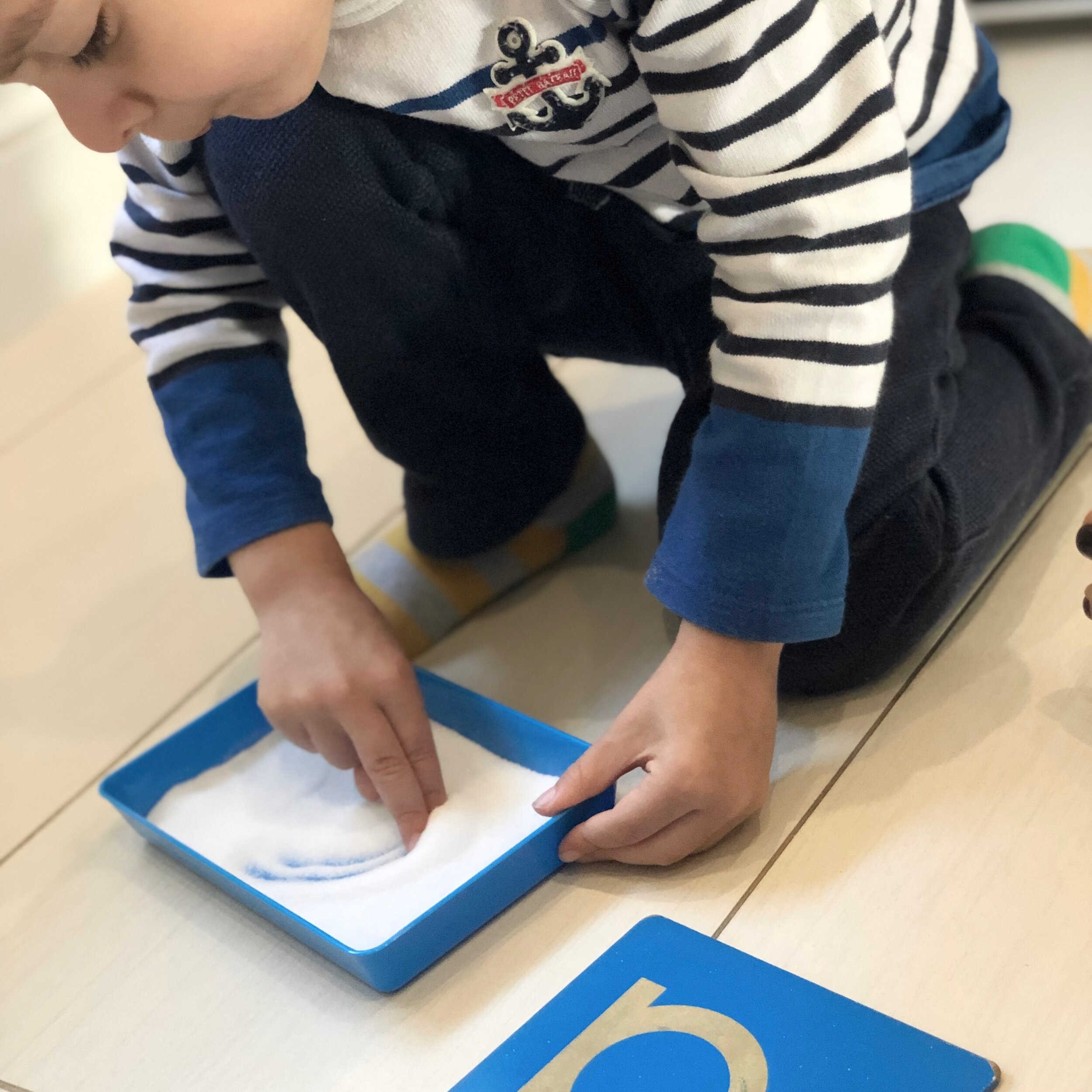Montessori Language Development- A Complete Guide for Parents (with Free Resources)
This article may contain affiliate / compensated links. For full information, please see our disclaimer here.
If you’re wondering how to support your child’s language development the Montessori way (from those first babbles all the way to confident reading) this guide is for you.
Maybe you’re new to Montessori and want to understand the process, or maybe you’ve been walking this path for a while but still have questions about what comes next. Either way, you’re in the right place.
And yes, I’ve included a free printable Montessori Language Cheatsheet below to help you map it all out.
Understanding Montessori Language Development
One of the things I love most about Montessori is that it starts with trust: the belief that children are already wired to learn language. As Dr. Maria Montessori observed, children don’t need formal instruction to learn to speak. They just need exposure to language in a rich, respectful, and responsive environment.
And that’s exactly what we can give them.
Montessori language development follows a natural, layered process:
Spoken Language Acquisition
Phonemic Awareness
Word Formation + Writing
Reading
Each phase builds on the one before it. And while the spoken word unfolds effortlessly in the early years (thanks to the absorbent mind), learning to read and write takes more structure and support.
Want a simple, step-by-step overview of the full Montessori language journey?
I've put together a free Montessori Language Cheatsheet that maps out every stage (from spoken language to early reading) so you can feel confident guiding your child at home.
It’s perfect whether you’re just starting out or want a clear snapshot of how it all fits together.
Get the cheatsheet + weekly Montessori inspiration
Sign up for my newsletter and receive:
✅ Instant access to the Montessori Language Cheatsheet
✅ Practical Montessori activities for home (ages 0-6)
✅ Screen-free play ideas that actually engage your kids
✅ Gentle parenting tips from real-life experience
No spam, just helpful resources from one mum to another. 💛
Join 12,000+ parents doing Montessori at home.
1) Spoken Language Acquisition
Let’s start at the beginning.
Children don’t learn to speak by us teaching them. They absorb it—through the tone of our voices, the rhythm of conversation, the words we use, and even the way we pause and wait.
In Montessori, we prepare the environment by:
Offering rich, precise vocabulary
Slowing down our speech
Letting children watch our mouths as we speak
Using everyday moments to model language (e.g., “Would you like a ripe, juicy pear or a crunchy apple?”)
And my favourite—bringing language to life with stories, songs, poems, and conversations that aren’t rushed.
✨ Pro Tip: Skip the baby talk. Use the real words. Children are capable of so much more than we think.
We also use the three-period lesson to introduce vocabulary clearly and respectfully:
This is a leaf.
Can you show me the leaf?
What is this?
The more a child hears language in context, the more their internal dictionary grows—and that becomes the foundation for everything else.
2) Phonemic Awareness
This is where things start getting magical.
Once a child has a solid foundation in spoken language, we gently begin helping them tune into the sounds that make up words. This is called phonemic awareness… a big phrase for the small steps that help a child hear, isolate, and manipulate sounds.
Why does this matter?
Because it’s the bridge between speaking and reading.
We support phonemic awareness through:
Sound games (like “I spy with my little eye something beginning with /s/”)
Rhymes and poetry
Songs with alliteration
Clear, slow articulation
Encouraging children to notice the beginning, middle, and ending sounds of words
Then come the beloved sandpaper letters… Montessori’s tactile way of connecting letter sounds to symbols. Children trace the letters with their fingers while saying the sound aloud, making a direct impression on the brain.
At home, we’ve used a DIY salt tray to mimic this stage… it’s simple, sensory, and effective.
3. Word Formation and Writing Skills
Writing doesn’t start with paper and pencil. In Montessori, it starts in the mind.
Children need to form words internally before they’re ever ready to write them down. This is why we first focus on word formation, and then the fine motor skills to express those thoughts on paper.
Montessori language development: Letter formation using Montessori sandpaper letters and the sand tray
Letter formation using the sand tray can be easily replicated at home using any regular tray with some salt. This is what we used at home, and it had the same effect.
Simple DIY version of the Montessori sand tray for language development
Once they’ve been introduced to sandpaper letters and practised writing in a tray, we bring out the moveable alphabet.
This is a game-changer.
It’s a wooden box of letters containing consonants in red and vowels in blue. Children use it to build words, then phrases, then whole sentences. All before they’ve ever held a pencil with confidence.
Here’s what we look for before introducing it:
✅ Can they identify individual sounds in words?
✅ Do they know the matching letter symbols?
✅ Can they blend letter sounds to form words?
Once these are in place, we support their writing through:
Moveable alphabet play
Pre-writing activities like metal insets, pin punching, painting
Slowly transitioning to writing letters with a pencil when they’re physically ready
There’s no rush. Writing is a journey, and this phase gives your child the tools and freedom to begin expressing themselves on their own terms.
4. Reading Ability
Now comes the part we can’t control, but we can prepare for.
Reading happens when it happens. Just like walking or talking, it’s a developmental leap. One day, seemingly out of nowhere, your child reads a word. And then another. And then you can’t stop them.
Most children who’ve had a Montessori foundation start reading between ages 4 and 6. But there’s no pressure. The groundwork you’ve laid will support them, whenever they’re ready.
Here’s how we support early reading:
Start with CVC words (consonant-vowel-consonant)
Use the Pink, Blue, Green series to gradually build phonetic complexity
Introduce non-phonetic (sight) words later on
Read aloud daily… with joy, not pressure
Celebrate the first word. And the fiftieth. But don’t rush the hundredth.
At home, we’ve loved the Waseca Reading Program. Honestly, it’s been such a gift in our Montessori journey—and a big reason why my kids are confident, joyful, lifelong readers today.
What makes Waseca so effective is how systematic and clear it is—without being rigid. It gently guides children through nine levels of phonetic understanding, with seven sub-sections in each level. Every new phonetic element is introduced with a hands-on, four-step process that just makes sense to a young learner:
Spell the word on the picture card using the moveable alphabet
Match label cards to the correct image, decoding sounds and often correcting their own spelling
Read phonetic words from a booklet that builds on the same principle
Trace and write the words by hand
There’s something so empowering about that moment when it all clicks—and this program makes those moments happen consistently, in a calm, self-paced way.
We used it with both our kids, and I can honestly say it’s what gave them their reading confidence. The structure helped them make sense of the English language, and the independence it encouraged gave them ownership of the process. That’s a huge part of why they both read today not just for school, but for fun. 🥹
If you want to read more about our personal experience (and get a full look inside the program), I wrote a detailed review of the Waseca Reading Program here.
You can also get $15 off your Waseca Reading Program purchase here if you’re ready to bring it into your own space.
Once they begin reading a few words, the Oxford reading series books are great as they progress in difficulty with the child. It gives great confidence to a child to be able to read an entire book on his own. We have loved this series in our home too.
If you take away one thing from this guide, let it be this:
There is no rush.
Language is already unfolding inside your child. Your job isn’t to push… it’s to prepare, observe, and support.
The Montessori approach to language development honours the whole child. It trusts the process. And when you trust it too, you’ll see the most beautiful thing unfold: a child who learns to read and write not just because they have to, but because they want to.
I’d love to hear from you:
Which stage are you currently navigating? What’s been your child’s favorite part of the language journey?
Send me an email, DM on on Instagram @east2westmama or share this post with someone who’d find it helpful.


